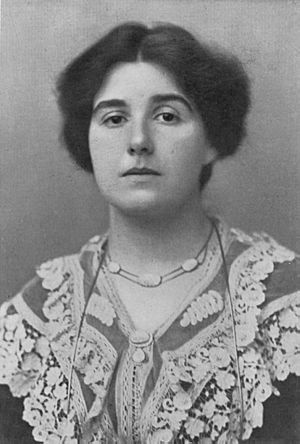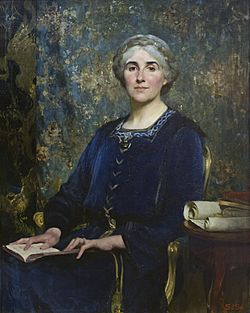Nina Salaman facts for kids
Quick facts for kids
Nina Salaman
|
|
|---|---|
 |
|
| Born | Pauline Ruth Davis 15 July 1877 Derby, Derbyshire, England |
| Died | 22 February 1925 (aged 47) Barley, Hertfordshire, England |
| Resting place | Willesden Jewish Cemetery |
| Occupation | Poet, translator, essayist |
| Language | English, Hebrew |
| Nationality | English |
| Notable works |
|
| Spouse | |
| Children | 6 (incl. Raphael Salaman and Ruth Collet) |
Pauline Ruth "Nina" Salaman (née Davis) (born July 15, 1877 – died February 22, 1925) was a British Jewish poet, translator, and social activist. She was known for her own poems. She was also famous for translating old Hebrew poems into English. She started publishing these translations when she was just 16 years old.
Nina Salaman strongly supported education for girls and women's right to vote. She was a key member of groups like the Jewish League for Woman Suffrage. She was also part of the Federation of Women Zionists and the Union of Jewish Women. Nina made history as the first woman to give a sermon in a British Orthodox synagogue. She was also chosen as the president of the Jewish Historical Society of England. However, she could not take on this role due to her health.
Contents
Nina Salaman's Early Life
Pauline Ruth Davis was born on July 15, 1877, in Derby, England. She was the second child of Louisa and Arthur Davis. Her father's family were Jewish people who made precise tools. They had moved to England from Germany in the early 1800s. Arthur Davis was a civil engineer. He also became an expert in the Hebrew language and studied ancient Hebrew texts.
When Nina was six weeks old, her family moved to Kilburn, London. Later, they settled in Bayswater. Nina's father made sure his daughters received a strong education in Hebrew and Jewish studies. He also took them to the synagogue regularly.
The Davis family knew many smart Jewish people. Friends included families like Nathan Adler and Solomon Schechter. These friends were interested in Nina's work. They helped her find publishers for her writings.
Her Amazing Career as a Writer
Early Writings and Translations
Nina's first published translation appeared in the Jewish Chronicle in 1894. She was only 16. Later that year, she wrote an essay and a poem for the Jewish Quarterly Review. After that, she kept publishing translations of old Hebrew poems in Jewish newspapers.
A friend of her father helped her connect with the Jewish Publication Society of America. This group published her book, Songs of Exile by Hebrew Poets, in 1901. This collection became very popular. It included poems by famous writers like Judah Halevi and Abraham ibn Ezra.
Around 1900, Nina's father worked on a new edition of the Machzor. This was a Jewish prayer book for holidays. Nina and her sister, Elsie, helped with this project. They turned the rhyming parts of the original text into poems. Their father translated the prose parts. The prayer book was published between 1904 and 1909. It became widely used in synagogues where English was spoken.
Family Life and Continued Work
Nina met her future husband, Redcliffe Salaman, in July 1901. He was a doctor. They got engaged ten days later and married on October 23, 1901. After their marriage, Redcliffe went to Berlin for more training in studying diseases.
In 1902, he became a director at the London Hospital. But he stopped practicing medicine the next year because of a serious lung illness. The Salamans spent a winter in Switzerland to help Redcliffe recover. When they returned to England, they moved to a large old country house in Barley, Hertfordshire.
Nina and Redcliffe Salaman lived comfortably. Their home followed Jewish dietary laws and traditions for the Sabbath. They often traveled to London for Jewish festivals and meetings. They also became active in the Jewish community in Cambridge. They welcomed many Jewish students into their home. Nina often visited the university library to do research. She also met with Israel Abrahams, a professor of Jewish religious texts. She personally taught her six children at home. She taught her sons to read Hebrew before they learned English.

After her marriage, Nina continued to write for Jewish magazines. These included the Jewish Chronicle and the Jewish Quarterly Review. She was a strong supporter of a Jewish homeland. In 1916, she published one of the first English translations of Hatikvah. This is now the Israeli national anthem. Later, she wrote a marching song for the Jewish soldiers. These soldiers helped the British take Palestine from the Ottoman Empire during World War I. Her husband served as a medical officer in this war.
In 1910, Nina published a book of her own poems called The Voices of the Rivers. It received good reviews. The next year, she released Apples and Honey. This was a special book for Jewish children. It included poetry and prose by famous writers like Benjamin Disraeli and Emma Lazarus.
Nina Salaman's most important work was Selected Poems of Jehudah Halevi. This book was released in 1924 after twelve years of preparation. It was part of a series of important Jewish books. The volume had an introduction by Nina Salaman about Halevi's life and work.
A Champion for Change
Besides her scholarly work, Nina Salaman was a leader in the Jewish League for Woman Suffrage. In this role, she fought for women to have the right to vote in synagogue elections. She also pushed for Hebrew education for Jewish girls. She was an active member of the Federation of Women Zionists and the Union of Jewish Women. She helped start a school for Jewish girls in North London. She donated the money she earned from her books to this school. She also took part in other charity groups, like the Women's Institute at Barley.
On December 5, 1919, Nina made history. She became the first woman to give a sermon in a British Orthodox synagogue. She spoke about the weekly Torah portion. Some people disagreed with this event. However, the Chief Rabbi, Joseph Hertz, supported her. He said that because she spoke after the main prayers, she hadn't broken any religious rules.
Nina Salaman joined the board of the Jewish Historical Society of England in 1918. She was chosen as president in 1922. But her poor health meant she couldn't take the job. Her husband was elected in her place.
Her Lasting Impact
Nina Salaman died from a serious illness at her home on February 22, 1925. She was 47 years old. Her funeral was held three days later at the Willesden Jewish Cemetery. The Chief Rabbi led the service and gave a speech praising her. This kind of speech is usually not allowed on that specific Jewish day. But it was made an exception for her because she was such an important scholar.
Many important people published messages honoring her memory. These included Abraham Yahuda, Herbert M. Adler, and Israel Zangwill.
Nina Salaman had six children. Her children included Myer Head Salaman, a scientist who studied diseases. Raphael Arthur Salaman was an engineer. Ruth Isabelle Collet was an artist. Esther Sarah Salaman was a singer. Another son, Edward Michael, died at age nine. Nina's granddaughter, Jenny Manson, is a leader of a political group. Another granddaughter, Nina Wedderburn, was a medical researcher.
A portrait of Nina Salaman by Solomon J. Solomon was bought by the Jewish Museum London in 2007.

